Physical Address
304 North Cardinal St.
Dorchester Center, MA 02124
Physical Address
304 North Cardinal St.
Dorchester Center, MA 02124
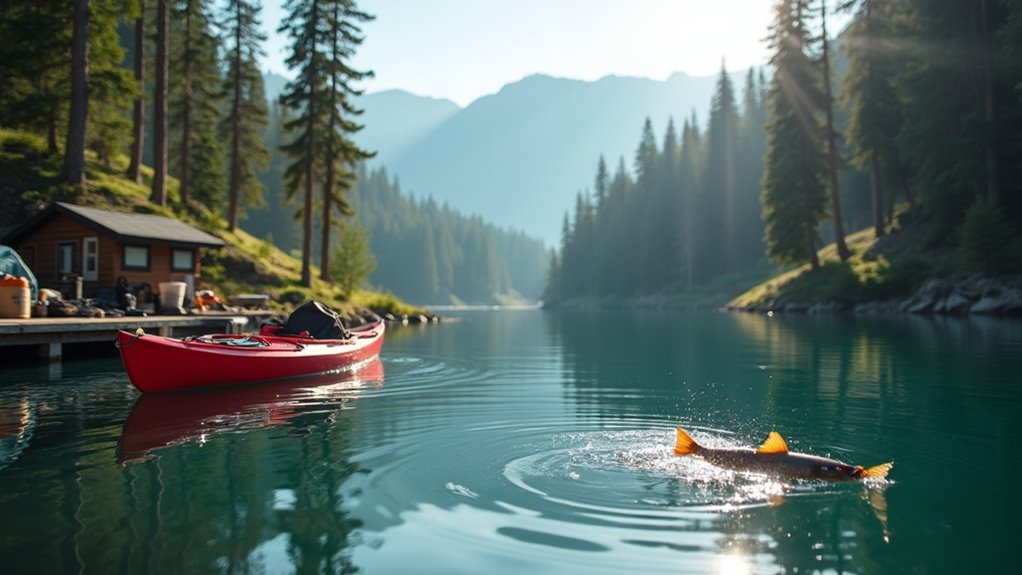
Nearby water sources at 70% of campgrounds offer budget-friendly aquatic adventures that most campers miss completely.
You probably don’t realize that over 70% of established campgrounds sit within a mile of natural water sources, yet most campers barely scratch the surface of available aquatic adventures. Whether you’re working with a shoestring budget or have some cash to spare, water activities can transform your ordinary camping trip into an unforgettable experience. From free pursuits that cost nothing more than your time to affordable gear rentals, there’s something here that’ll perfectly match your adventure style and wallet.
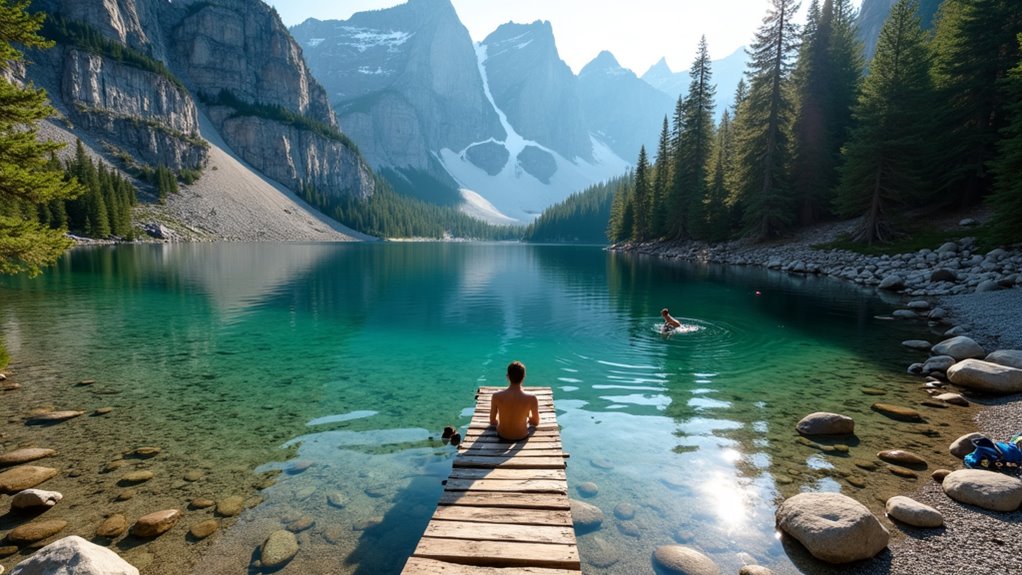
When you’re camping near natural bodies of water, swimming offers one of the most invigorating and cost-free ways to cool off after a long day of hiking or setting up camp.
Before diving in, test the water temperature and check for currents, depth changes, and underwater obstacles like rocks or fallen branches. Look for designated swimming areas when available – they’re typically safer and cleaner.
Safety first: always assess water conditions, currents, and potential hazards before taking your first splash into natural swimming spots.
Always swim with a buddy and stay close to shore if you’re not a strong swimmer. Pack water shoes to protect your feet from sharp stones and slippery surfaces.
Consider bringing a mesh bag to collect any trash you spot, keeping these natural spaces pristine for future campers.
Swimming together creates wonderful bonding opportunities for couples camping and strengthens relationships through shared outdoor experiences.
Natural swimming beats any expensive water park.
While gentle lake swimming offers peaceful relaxation, white-water rafting pumps up the adrenaline and creates unforgettable camping memories. You’ll navigate churning rapids, dodge rocks, and work as a team to conquer nature’s wildest waterways.
Choose guided trips for your first adventure—they’ll provide equipment, safety training, and expert navigation. Half-day excursions typically cost $50-80 per person, while full-day trips run $80-150. You’ll get a paddle, life jacket, helmet, and often a wetsuit.
Book during shoulder seasons for better rates and smaller crowds. Class II-III rapids offer excitement without extreme danger for beginners.
Bring quick-dry clothes, secure footwear, and waterproof cases for phones. Many outfitters include lunch and photos, making it an excellent value for thrill-seeking campers.
For truly unique experiences, consider exploring some of the world’s most offbeat rafting destinations in Asia, where pristine rivers and stunning landscapes create once-in-a-lifetime adventures.
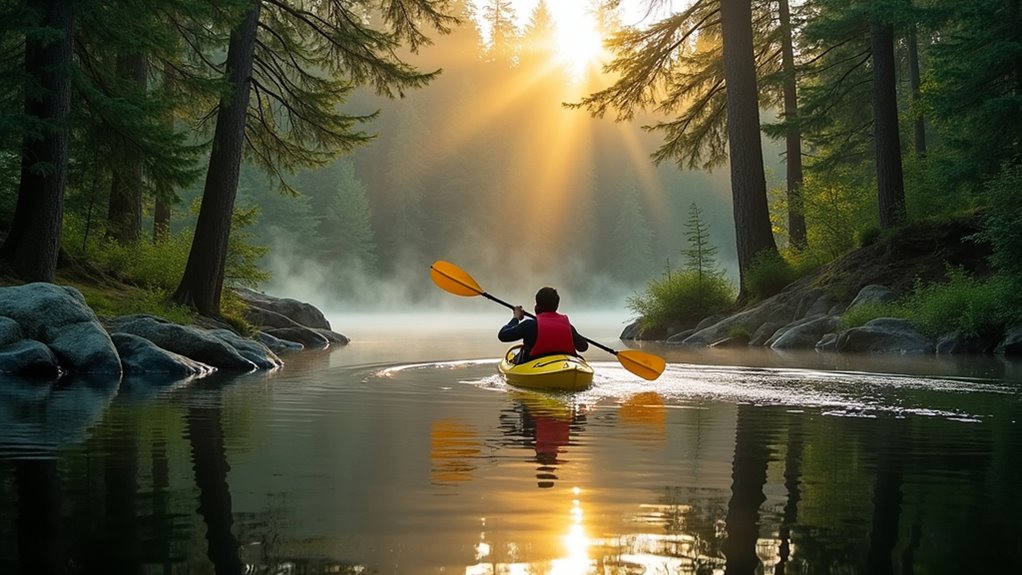
Though white-water rafting delivers heart-pounding thrills, kayaking lets you explore waterways at your own pace while enjoying stunning scenery and wildlife encounters. You’ll paddle through calm lakes, gentle rivers, and protected coves where herons fish and eagles soar overhead.
Start with a basic sit-on-top kayak—they’re stable, affordable to rent, and perfect for beginners. Pack a waterproof bag with snacks, water, and your phone. Choose protected waters like state park lakes or slow-moving rivers for your first outings.
Early morning trips offer the best wildlife viewing and cooler temperatures. You’ll often spot deer drinking at water’s edge, turtles sunning on logs, and various waterfowl.
Many campgrounds rent kayaks for $25-40 daily, making this an accessible adventure that doesn’t break your camping budget. For RV travelers, kayaking perfectly complements eco-friendly living by offering a zero-emission way to explore nature’s waterways.
Stand-up paddleboarding offers an even more immersive water experience that gets you closer to the surface and surrounding nature. Dawn’s your golden hour – calm waters, minimal wind, and breathtaking sunrise views make for perfect paddling conditions.
You’ll need a basic SUP board, paddle, and personal flotation device. Many campgrounds near lakes rent equipment affordably, saving you transportation hassles. Start in shallow water to practice your balance before venturing deeper.
The learning curve‘s gentle – most beginners manage to stand within their first session. Focus on engaging your core and keeping knees slightly bent. Paddle strokes should be smooth and deliberate.
Early morning paddling rewards you with wildlife sightings and mirror-like water reflections. It’s also cooler, preventing overheating during summer camping trips. When planning your water adventures, remember that selecting the right camping tent ensures you have a comfortable base camp to return to after your paddleboarding sessions.
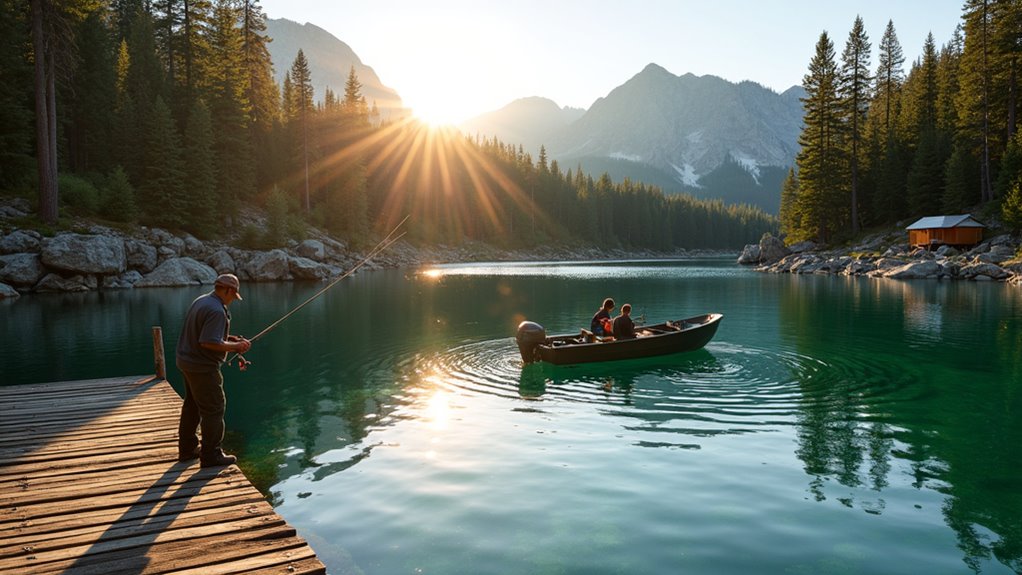
Two fishing approaches await you at most camping destinations – casting from shoreline spots or heading out on the water. Shore fishing costs nothing extra and lets you fish while kids play nearby. Scout rocky points, fallen trees, and creek mouths where fish gather. You’ll need basic tackle: hooks, sinkers, bobbers, and local bait like worms or minnows.
Boat fishing opens deeper waters but requires rental fees or bringing your own craft. Canoes and kayaks work great for quiet lake fishing, while motorboats reach distant hotspots quickly. Pack a cooler, net, and fillet knife if you’re keeping your catch.
Check local regulations for licenses, limits, and seasonal restrictions. Early morning and evening typically produce the best results for both approaches.
While fishing offers peaceful relaxation, some campers crave heart-pounding adventure above the water’s surface. Cliff jumping delivers that adrenaline rush you’re seeking, but it demands respect and preparation.
Scout your jumping spot thoroughly before leaping. Check water depth—you’ll need at least 12-15 feet of clear, deep water. Look for hidden rocks, logs, or debris below. Test the water first by throwing stones to gauge depth and obstacles.
Start small with lower jumps to build confidence. Never jump alone—bring a buddy for safety. Check local regulations since some areas prohibit cliff jumping.
Position your body correctly: feet first, arms at your sides, and body straight. This free activity offers maximum thrills for zero cost, making it perfect for budget-conscious adventurers wanting unforgettable camping memories.
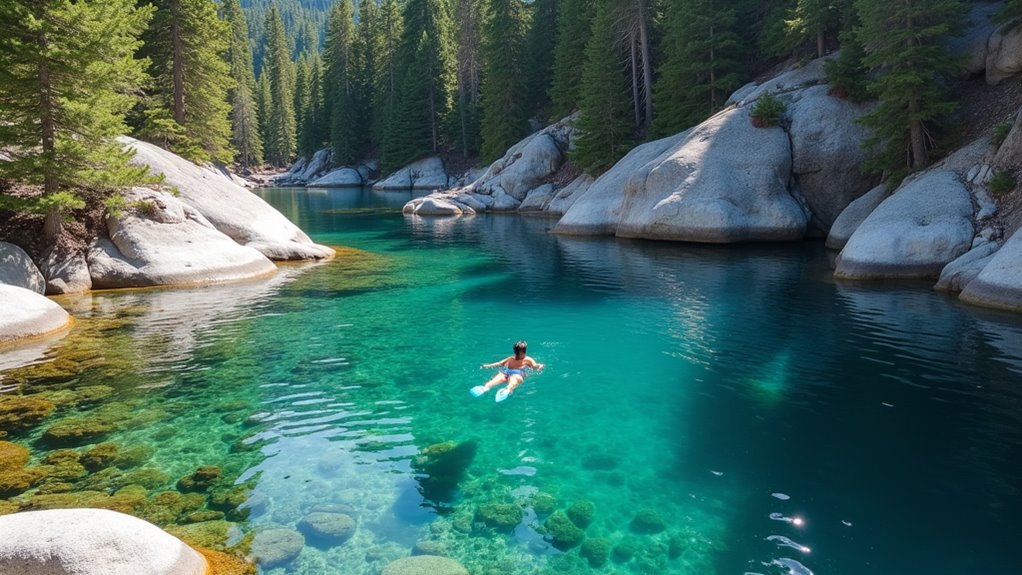
Why settle for observing water from above when you can explore the hidden world beneath mountain springs? Snorkeling in crystal-clear springs offers an affordable adventure that doesn’t require extensive training or expensive equipment.
You’ll need basic gear: mask, snorkel, and fins. Most camping stores rent equipment for $15-25 daily, making this accessible for budget-conscious adventurers. Mountain springs maintain consistent temperatures year-round, typically 68-72°F, so you won’t need a wetsuit in warmer months.
Look for springs with visibility exceeding 50 feet – you’ll spot native fish, underwater rock formations, and aquatic plants. Popular locations include Florida’s Blue Springs, Texas’s Jacob’s Well, and California’s Crystal Cove.
If you’re planning multiple snorkeling adventures throughout the season, consider whether renting or buying your gear makes more financial sense for your camping lifestyle.
Always check local regulations and respect wildlife. Remember: take only photos, leave only bubbles.
After exploring underwater worlds, you might crave a more relaxed water adventure that keeps you comfortably above the surface. Canoeing down peaceful streams offers the perfect blend of gentle exercise and scenic exploration without breaking your camping budget.
Most campgrounds near waterways rent canoes affordably, or you can bring your own inflatable model. You’ll glide silently through nature while spotting wildlife along the banks.
Essential canoeing tips for beginners:
Stream canoeing lets you cover more ground than hiking while staying cool and refreshed throughout your adventure. Whether you’re navigating gentle currents or exploring quiet backwaters, following essential tips will ensure your paddling experience remains safe and enjoyable.

Looking for an even more leisurely water experience than canoeing? Tubing on lazy rivers offers the ultimate relaxation. You’ll float downstream at nature’s pace while soaking up sunshine and scenery.
Most tube rentals cost $15-25 per person and include transportation back to your starting point. Bring a waterproof bag for essentials like sunscreen, snacks, and your phone. Wear water shoes since you’ll occasionally need to push off rocks or shallow spots.
Choose rivers with minimal rapids – Class I or calm stretches work best. Popular tubing destinations often provide coolers that float alongside you.
Don’t forget a hat and plenty of sunscreen since you’ll be exposed for hours.
The slow pace lets you spot wildlife, chat with friends, and truly unwind. It’s perfect after active camping days. For those seeking an even more immersive multi-day adventure, canoe camping combines paddling with overnight stays in scenic wilderness locations.
While tubing offers pure relaxation, water skiing and wakeboarding amp up the adrenaline for campers craving high-energy thrills. You’ll need access to a powerboat and some basic gear, but many lakeside campgrounds offer rental equipment at reasonable rates.
For campers seeking an adrenaline rush beyond gentle tubing, water skiing and wakeboarding deliver heart-pumping excitement on the lake.
Before hitting the water, master these fundamentals:
Start with shorter sessions to build confidence and stamina.
You’ll quickly discover why these sports have such devoted followings among camping enthusiasts.
For an equally thrilling water adventure, consider rafting in the Smokies where rushing rapids provide a different kind of high-energy water sport experience.
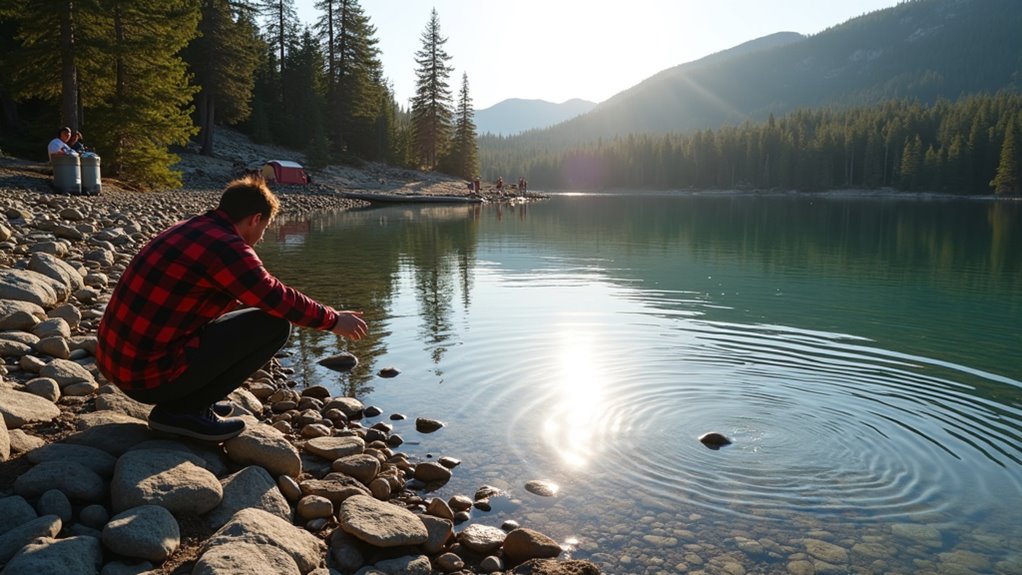
Though rock skipping might seem like simple child’s play, turning it into a camping competition creates surprisingly intense entertainment that costs absolutely nothing. You’ll need flat stones from the shoreline and basic rules: count skips, measure distance, or track consecutive successful throws.
Set up different categories like most skips, longest distance, or best technique style. You can create brackets for adults versus kids, or mix groups for family-friendly competition. Mark throwing lines with sticks or rope, and designate judges to count skips fairly.
The beauty lies in its simplicity—no equipment purchases, no permits required. Everyone can participate regardless of skill level, making it perfect for large camping groups. Plus, you’re teaching kids patience and physics while they’re having fun.
After the competition, participants can unwind in a jungle hammock strung between nearby trees, sharing stories about their best throws and planning strategies for the next round.
After you’ve collected plenty of stones for skipping, you’ll likely notice some perfect stacking rocks among your pile. Building cairns by the water creates a peaceful, meditative activity that costs absolutely nothing while connecting you with nature.
Choose flat, stable stones and start with your largest as the foundation. Balance each successive stone carefully, finding the sweet spot where it naturally sits. Here’s what makes cairn building special:
This quiet activity perfectly complements other camping experiences that help you disconnect from daily stress and truly appreciate the outdoors. Remember to dismantle your cairns before leaving to preserve the natural environment for wildlife and other campers.
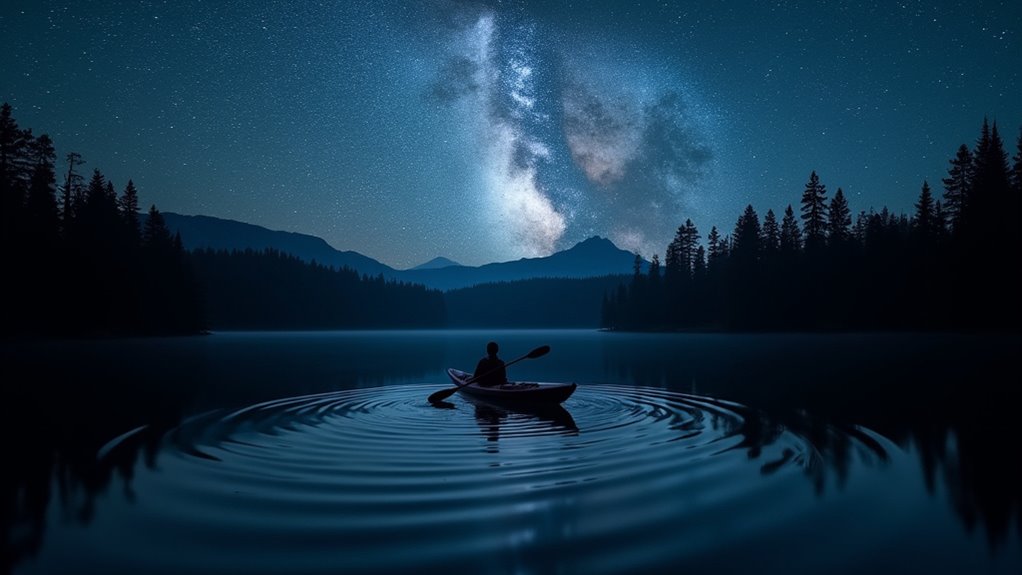
Once darkness settles over your campsite, the water becomes your front-row seat to nature’s most spectacular light show. You’ll find that lakes and calm rivers offer perfect platforms for stargazing without expensive equipment. Simply wade in waist-deep or float on your back using a basic pool noodle or inflatable mat.
Water eliminates light pollution that surrounds most shorelines, giving you clearer views of constellations. The gentle motion helps you relax while scanning the sky. Bring a waterproof phone case to use star identification apps, or download offline star maps beforehand to save data.
Time your sessions during new moon phases for maximum visibility. Keep sessions short in cold water to prevent hypothermia, and always inform someone of your nighttime water plans. Before heading into the water for stargazing, review essential hiking tips to ensure you’re properly prepared for navigating back to your campsite in the dark.
Why settle for admiring waterfalls from below when you can experience them up close through rappelling and climbing? This thrilling activity transforms your camping trip into an unforgettable adventure while keeping costs reasonable.
Take your camping adventure beyond ordinary sightseeing and discover the exhilarating rush of waterfall rappelling without breaking your budget.
You’ll need basic climbing gear, which many outdoor shops rent affordably. Start with shorter falls to build confidence before tackling larger cascades. The rush of descending alongside rushing water creates memories that’ll last forever.
Essential considerations for waterfall adventures:
Always inform someone of your plans and expected return time. This affordable adventure adds serious excitement to any camping experience.
For those seeking even more challenging vertical adventures, consider exploring glacier climbing trails that offer unique ice and snow conditions throughout various US locations.
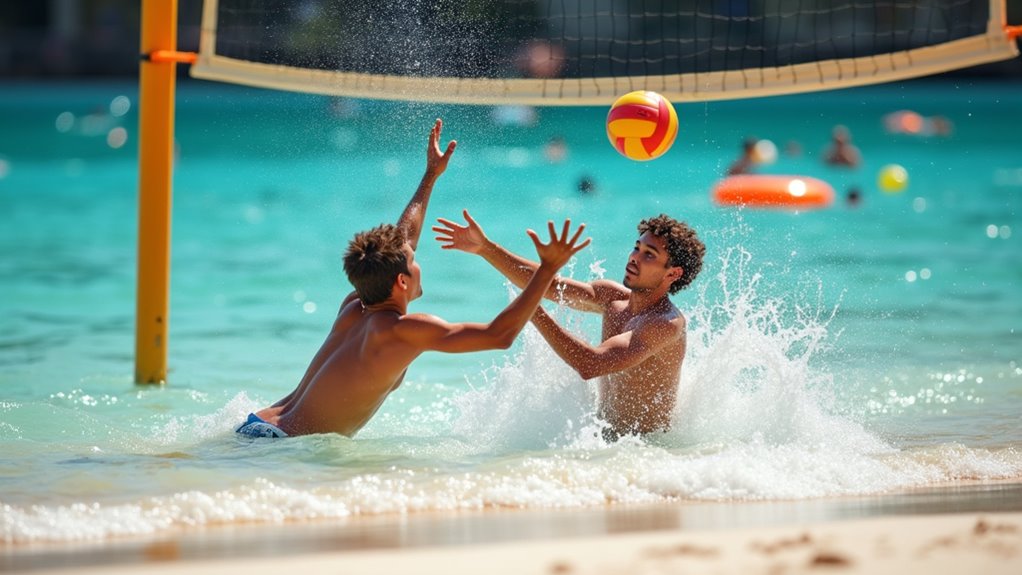
When you’re camping near a lake or beach, volleyball and water games transform any ordinary day into a social celebration without breaking your budget. You’ll need minimal equipment—just a volleyball and net, which most campgrounds provide or you can borrow from fellow campers.
Set up your court in shallow water for added challenge and cooling relief. Water volleyball becomes more entertaining as players struggle against resistance while spiking and diving. Between matches, organize relay races, water tag, or tug-of-war using a rope.
These activities work perfectly for mixed-age groups and skill levels. You’ll burn calories, stay cool, and create lasting memories with friends and family. Pack a frisbee as backup entertainment—it floats and works equally well on sand or in water.
After working up a sweat from all the activity, you can retreat to your RV cool and comfortable with the right preparation and equipment.
You’ll discover that water activities transform your camping trip like adding color to a black-and-white photo—suddenly everything becomes vivid and memorable. Studies show campers who engage in water activities report 40% higher satisfaction with their outdoor experience. Whether you’re skipping stones with your kids or paddling at sunrise, these adventures won’t break your budget but will create priceless memories. Pack your gear, embrace the splash, and let nature’s playground rejuvenate your spirit this season.